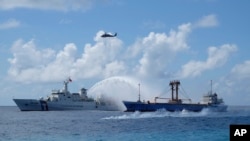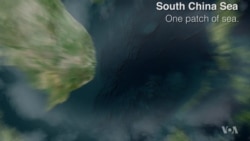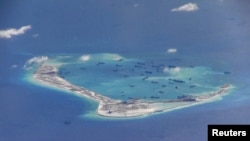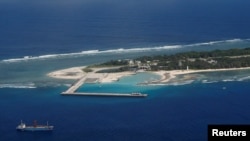Taiwan President Tsai Ing-wen is risking a new showdown with Beijing by stepping up military capabilities to protect holdings in the widely contested South China Sea.
The navy of Taiwan, a diplomatically isolated government that claims the entire sea and controls its largest land feature, will increase patrols in the 3.5 million-square-kilometer body of water because of China's own growing military might, Defense Minister Feng Shih-kuan told parliament in Taipei last week. The navy will also train together with the air force, the minister said.
He added the navy will use its increased, regular South China Sea patrols to do humanitarian rescue drills and protect Taiwanese boats trawling for fish or ferrying supplies. A 1,000-ton coast guard frigate has already been sent to the sea to protect Taiwanese fishing boats.
Use of military units to enforce Taiwan's access to the resource-rich sea off its southwest coast may prompt a backlash from Beijing because of poor existing relations and little external support, experts fear.
"In response to this, if China did something in the South China Sea, more exercises, more ship passing through, that's a marginal change from the status quo," said Ross Feingold, Taipei-based analyst with an American political consultancy.
"But if it wants to express its displeasure at Taiwan, it could do more of the kinds of exercises it has been doing recently around Taiwan island, even though Taiwan island is not relevant really to the South China Sea dispute," he said.
In December and January, China's aircraft carrier circled Taiwan, and last week it sent military aircraft into waters close to Japan's outlying islands and due east of Taiwan. The Defense Ministry monitored both moves.
Beijing claims about 95 percent of the South China Sea. Since 2010 it has angered Taiwan as well as five Southeast Asian maritime claimants by landfilling once uninhabitable islets, adding military installations and letting Chinese vessels enter disputed tracts.
Few diplomatic options
Southeast Asian countries such as Vietnam and the Philippines can use formal diplomatic ties with China to work out agreements. But China claims Taiwan itself as part of Chinese territory, even though Taiwan has been self-ruled since the 1940s. That schism has barred any formal diplomacy.
Taiwan, squeezed by China for seven decades, has no diplomatic relations in Asia. Tsai talked briefly about security in December with U.S. President Donald Trump, but Trump has shown no further sign of support.
An informal China-Taiwan dialogue of eight years ended after Tsai took office in May on a public mandate to be more cautious toward Beijing. China had also "refrained from harassing" Taiwanese fishermen at that time, said Jonathan Spangler, director of the Taipei-based South China Sea Think Tank.
He added that contact with other countries at sea "could give Beijing reason to intervene in a way that would be detrimental to Taiwan's interests."
Beijing would factor its current struggle with Taiwan into any response to Taiwan's activities in the sea, said Liu Fu-kuo, international relations research fellow at National Chengchi University in Taipei.
"President Tsai Ing-wen, even if other senior officials spoke so much about different points of South China Sea policy, every time it comes to her she said that ‘no change,'" Liu told a news forum Friday.
"And this is the policy our government is currently taking," Liu said. "I just hope there won't be any things that she will change, because it has closer links with cross-Strait relations."
Taiping Island
Taiwan now holds Taiping Island, the largest of the Spratly Island chain, as well as a nearby sandbar. Taiping is unusually well developed, with a coast guard base, meteorological research equipment and a collection of solar panels.
Tsai, however, has shown no signs of trying to extend control over the sea, which is prized for fisheries, undersea fossil fuel reserves and marine shipping lanes.
The president may ultimately carry on her predecessor's effort to develop Taiping as a base for solar energy, marine research and humanitarian rescues, scholars say. Former president Ma Ying-jeou, in office from 2008 until last year, had pursued those programs to show off what his Foreign Ministry called Taiwanese "soft power," while keeping peace with China.
Tsai's Interior Ministry said in August it aimed to position observation facilities on Taiping Island and pursue global cooperation on climate issues. In November, the coast guard and Defense Ministry announced plans for "humanitarian" rescue exercises around the island.
But Taiping, which measures 1,400 meters long and 400 meters across, is still run by "well-trained military people," former defense minister Andrew Yang said.
"The main approach is how to fully utilize our soft powers on the Spratlys instead of increasing the military installations," Yang told the forum Friday. "In the future I think this is going to be increasingly enhanced, particularly the scientific maritime research activities."












